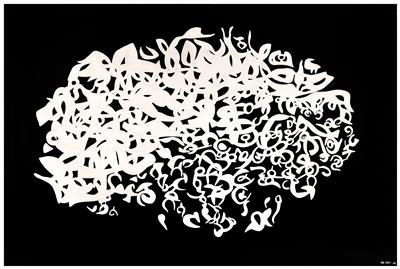Carla Accardi *

(Trapani 1924–2014 Rome)
Integrazione Ovale, 1958, signed and dated ‘58; inscribed, signed and dated again on the reverse, casein on canvas, 131 x 197 cm, framed
Provenance:
Jacorossi Collection, Rome
Galleria Notizie, Turin (stamp on the reverse)
Studio Casoli, Milan
Gianni Manzo Collection, Milan
Giangaleazzo Visconti Collection, Milan
European Private Collection
Exhibited:
Rome, Carla Accardi, Galleria La Salita, 12 April 1958
Tokyo, IX Tokyo Biennal, Metropolitan Art Gallery, 1961, exh. cat. no. 6 (titled “Structure n. 3”, with wrong dimensions and technique)
Genoa, Accardi, Galleria La Polena, 12 February - 10 March 1970
Turin, Galleria Martano, 26 February-20 March 1981 (titled ”Struttura
n. 3” with wrong dimensions)
Rome, In superficie, Studio Durante, December 1989-January 1990, exh. cat. no. 1
Catania, Carla Accardi. Segno e trasparenza, Fondazione Puglisi Cosentino, Palazzo Valle, 6 February-12 June 2011, exh. cat. p. 110 with ill.
Literature:
Germano Celant, Carla Accardi, Charta, Milan 1999, p. 267,
no. 1958–2 with ill.
In the early years of the 1950s, the preconditions of a profound internationalisation of Italian artistic culture were evident, and deeply permeated by foreign as much as domestic stimuli: Italian gallery owners secured increasing numbers of exhibitions overseas, Venturi held lectures on the New York avant-garde movements, and writers such as Flaiano, Moravia, and Elsa Morante accentuated the de-realisation of writing in favour of a language of the imagination; in 1951 Namuth’s photographs depicting Pollock in the midst of his creative process of drippings, in which he would walk and dance around untouched canvases laid out on the ground, began to circulate.
Thus the idea of the first white on black paintings was born: “It was a year of crisis, I was very demotivated and I thought I was unable to paint anymore. And in isolation I began to paint straight on the ground, to trace signs. But I used white on black because black on white didn’t excite me as it was too obvious; in that particular moment the artist has to have a sense of uniqueness, of novelty that spurs her on.”
These lines decisively describe the emergence of an ‘anti-painting’ comprised of contrasts, inversions, of movement that overthrows the hierarchy of form and colour, of the relationships between unlimited and individual vision, passing through the dissolution and the crisis of tradition. This is what Accardi searches for in her painting, where a sign alone does not matter in itself, but exists in relation to other signs of the moment which together create a structure, and become a form of artistic expression (within the structure), acquiring in the process a magical and intelligent meaning of rigorous necessity, but also of unpredictable play.
27.11.2018 - 18:00
- Dosažená cena: **
-
EUR 295.800,-
- Odhadní cena:
-
EUR 160.000,- do EUR 240.000,-
Carla Accardi *
(Trapani 1924–2014 Rome)
Integrazione Ovale, 1958, signed and dated ‘58; inscribed, signed and dated again on the reverse, casein on canvas, 131 x 197 cm, framed
Provenance:
Jacorossi Collection, Rome
Galleria Notizie, Turin (stamp on the reverse)
Studio Casoli, Milan
Gianni Manzo Collection, Milan
Giangaleazzo Visconti Collection, Milan
European Private Collection
Exhibited:
Rome, Carla Accardi, Galleria La Salita, 12 April 1958
Tokyo, IX Tokyo Biennal, Metropolitan Art Gallery, 1961, exh. cat. no. 6 (titled “Structure n. 3”, with wrong dimensions and technique)
Genoa, Accardi, Galleria La Polena, 12 February - 10 March 1970
Turin, Galleria Martano, 26 February-20 March 1981 (titled ”Struttura
n. 3” with wrong dimensions)
Rome, In superficie, Studio Durante, December 1989-January 1990, exh. cat. no. 1
Catania, Carla Accardi. Segno e trasparenza, Fondazione Puglisi Cosentino, Palazzo Valle, 6 February-12 June 2011, exh. cat. p. 110 with ill.
Literature:
Germano Celant, Carla Accardi, Charta, Milan 1999, p. 267,
no. 1958–2 with ill.
In the early years of the 1950s, the preconditions of a profound internationalisation of Italian artistic culture were evident, and deeply permeated by foreign as much as domestic stimuli: Italian gallery owners secured increasing numbers of exhibitions overseas, Venturi held lectures on the New York avant-garde movements, and writers such as Flaiano, Moravia, and Elsa Morante accentuated the de-realisation of writing in favour of a language of the imagination; in 1951 Namuth’s photographs depicting Pollock in the midst of his creative process of drippings, in which he would walk and dance around untouched canvases laid out on the ground, began to circulate.
Thus the idea of the first white on black paintings was born: “It was a year of crisis, I was very demotivated and I thought I was unable to paint anymore. And in isolation I began to paint straight on the ground, to trace signs. But I used white on black because black on white didn’t excite me as it was too obvious; in that particular moment the artist has to have a sense of uniqueness, of novelty that spurs her on.”
These lines decisively describe the emergence of an ‘anti-painting’ comprised of contrasts, inversions, of movement that overthrows the hierarchy of form and colour, of the relationships between unlimited and individual vision, passing through the dissolution and the crisis of tradition. This is what Accardi searches for in her painting, where a sign alone does not matter in itself, but exists in relation to other signs of the moment which together create a structure, and become a form of artistic expression (within the structure), acquiring in the process a magical and intelligent meaning of rigorous necessity, but also of unpredictable play.
|
Horká linka kupujících
Po-Pá: 10.00 - 17.00
kundendienst@dorotheum.at +43 1 515 60 200 |
| Aukce: | Post-War e Současné umění I |
| Typ aukce: | Salónní aukce |
| Datum: | 27.11.2018 - 18:00 |
| Místo konání aukce: | Wien | Palais Dorotheum |
| Prohlídka: | 17.11. - 27.11.2018 |
** Kupní cena vč. poplatku kupujícího a DPH
Není již možné podávat příkazy ke koupi přes internet. Aukce se právě připravuje resp. byla již uskutečněna.
